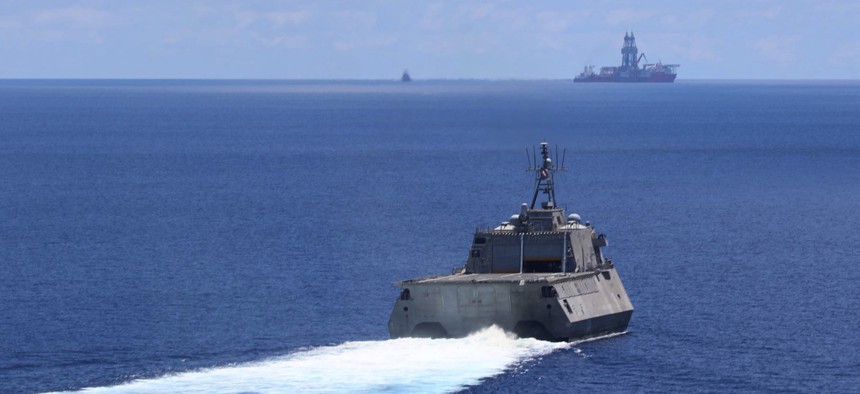
USS Montgomery (LCS 8) sailed near a Panamanian-flagged drillship in the South China Sea last year. U.S. Navy/AWS3 Christopher Fred
Biden’s Defense Budget Will Worry America’s Indo-Pacific Allies
Spending to boost the U.S. military's future edge comes at the expense of addressing today's shortfalls in capacity and warfighting effectiveness.
Pentagon leaders have recently been at pains to convince the world that China is their top priority. But President Joe Biden’s first defense budget request tells a somewhat different story: For all of the emphasis on China as the “pacing threat” and on the need to “revitalize” U.S. alliances and partnerships, the Biden administration views the Indo-Pacific’s eroding military balance as a future challenge, not an urgent problem that demands real resources today.
This is deeply troubling for America’s Indo-Pacific allies. Living with the everyday reality of China’s coercive statecraft and rapidly expanding strategic presence, regional countries need the Pentagon to ramp-up investments in their security and bolster conventional deterrence right now. But the 2022 budget request is more focused on building a war-winning force for the 2030s than reducing near-term risks in the Indo-Pacific this decade.
So important is this future objective that the Pentagon’s $5.1 billion Pacific Deterrence Initiative – a congressional mechanism set up to drive additional funds to U.S. Indo-Pacific Command for pressing regional needs – has been all but dissolved into the administration’s future-oriented budget. Coupled with the uncomfortable fact that U.S. defense spending is now falling in real terms, Indo-Pacific allies are left wondering whether Washington’s current priorities align with their own.
It’s not that the Biden administration’s focus on the long-term China challenge is misplaced. Beijing’s unprecedented military buildup and ongoing modernization program is undercutting the foundations of American power in the Indo-Pacific. With its rapid investments in hypersonic missiles, artificial intelligence, quantum computing, and other advanced technologies, China’s military is on a trajectory to become an even more formidable adversary by the mid-2030s – forcing America to devise “a new way of war” to head-off the threat.
On this score, the administration’s budget request moves in the right direction. A record $112 billion for research and development will see the Pentagon accelerate its ability to deploy game-changing technologies in a high-end future fight. Big bets are being placed on long-range missiles, networked warfighting systems, microelectronics, and nuclear modernization; while legacy platforms ill-equipped for great power competition are being mothballed. It’s a time-consuming strategy to out-innovate and out-modernize China that augments the administration’s wider focus on U.S.-China technology competition.
The problem is that investments in America’s future edge come at the expense of addressing present-day shortfalls in U.S. military capacity and warfighting effectiveness. This is what worries Indo-Pacific allies. Unwilling to lift defense spending due to political and fiscal concerns, the Biden administration wants to pay for its next-decade China strategy with an $8 billion cut to new weapons procurement, paving the way for an older and smaller force.
Among the consequences: A Navy shrinking well short of its 355-ship goal and an Air Force declining significantly faster than its replenishment rate. Moreover, with defense spending on operations and maintenance growing slower than inflation, there’s a risk of a prolongation of the readiness problems that have plagued the force since 2017. All this bodes poorly for an Indo-Pacific strategic balance in which China’s growing military might already has a coercive quality of its own.
These risks might be tolerable if the budget request incorporated targeted investments to strengthen America’s position in the Indo-Pacific throughout the 2020s. After all, structural deficiencies in the armed forces can be mitigated for key regions – as the Pentagon has done for the Middle East and Europe – by prioritizing the military demands of those theatres.
This is why, from a regional perspective, it’s so worrying that the Pacific Deterrence Initiative has been gutted in almost all but name. Drawn-up with bipartisan congressional support by former U.S. Indo-Pacific commander, Admiral Philip Davidson, this initiative should be funding a more resilient and distributed military posture for U.S. forces west of Hawaii; boosting regional stocks of munitions, fuel, and logistics enablers; strengthening integrated air defenses and radars; and increasing exercises and capacity-building assistance with frontline allies and partners.
Such efforts would reduce near-term risks of deterrence failure by enhancing America’s ability to deny China a quick and easy victory in contested parts of the region. But these priorities have been ditched in favor of buying ships and aircraft that may never even venture into the Pacific. Worse, reports are swirling that Pentagon analysts actually scurried the Pacific Deterrence Initiative’s original priorities on the basis that it’s now simply too dangerous to put more U.S. assets in the region.
These are not the signals that Washington should be sending its Indo-Pacific allies. Following a series of official speeches, assessments, and classified wargames that suggested America might fail to deter, or could even lose, a war with China, regional countries are justifiably anxious about the sustainability of U.S. military power. They are also tired of waiting on the Pentagon to align its budget priorities with the mantra that the Indo-Pacific is its “priority theatre.”
America’s Indo-Pacific allies want to work with the administration to bolster the regional order today. Australia, for example, is investing heavily in long-range strike, pursuing a more active regional order-defending strategy, and looking to deepen U.S.-Australia Indo-Pacific military posture through a new working group. Japan is expanding its amphibious rapid deployment brigade to improve island-chain defense and brokering an alliance conversation about strengthening deterrence over Taiwan.
It’s not too late for the Biden administration to set things right. If the Pentagon has come to a different assessment about the Indo-Pacific’s near-term threat environment, regional allies want to know. But if it’s putting the long-term China challenge ahead of today’s eroding strategic order, then it should heed its allies’ concerns and double-down on investments in regional deterrence now.



